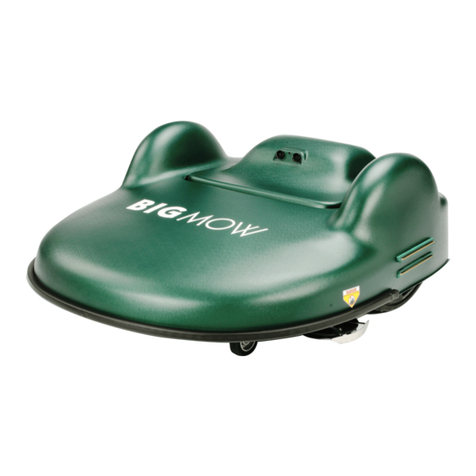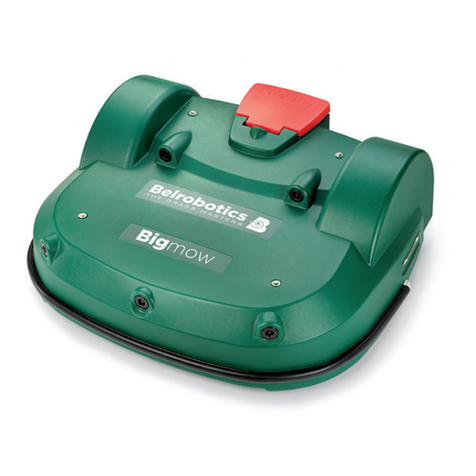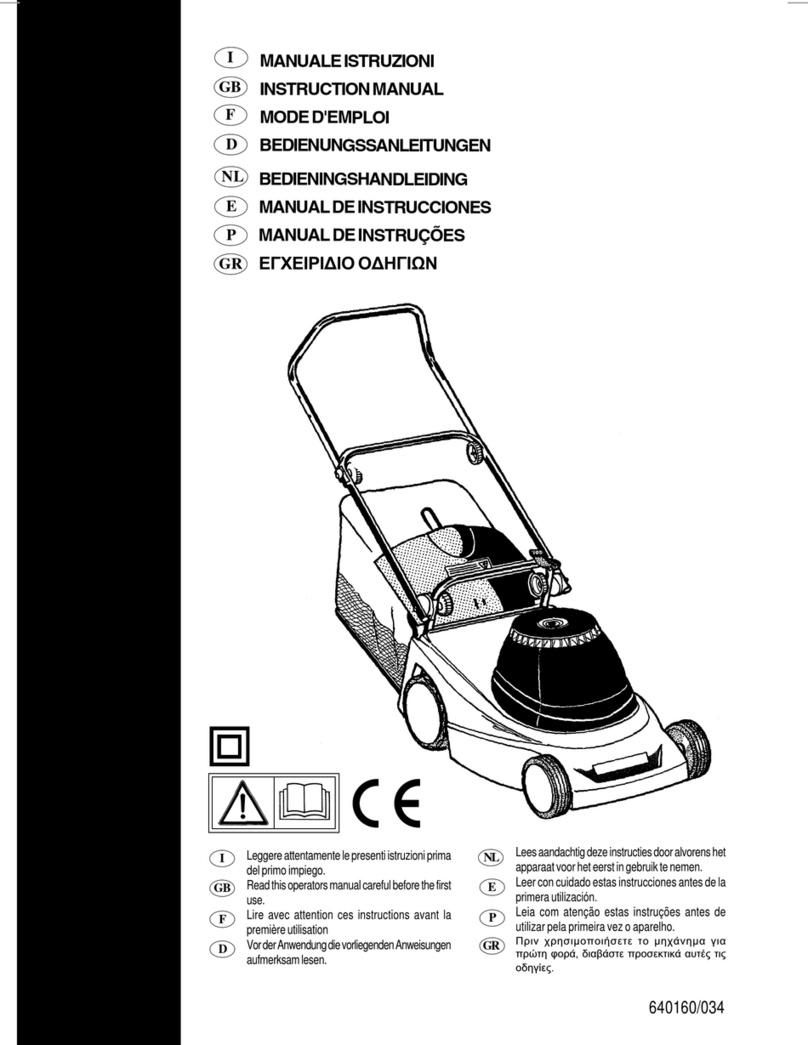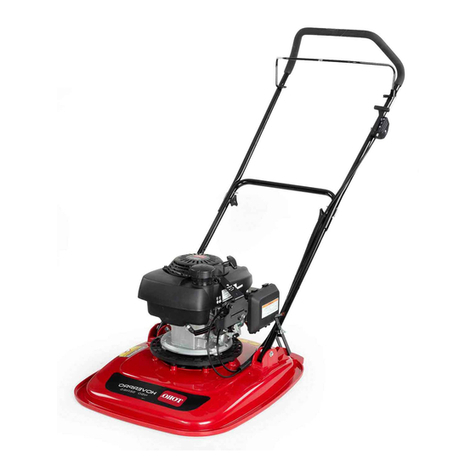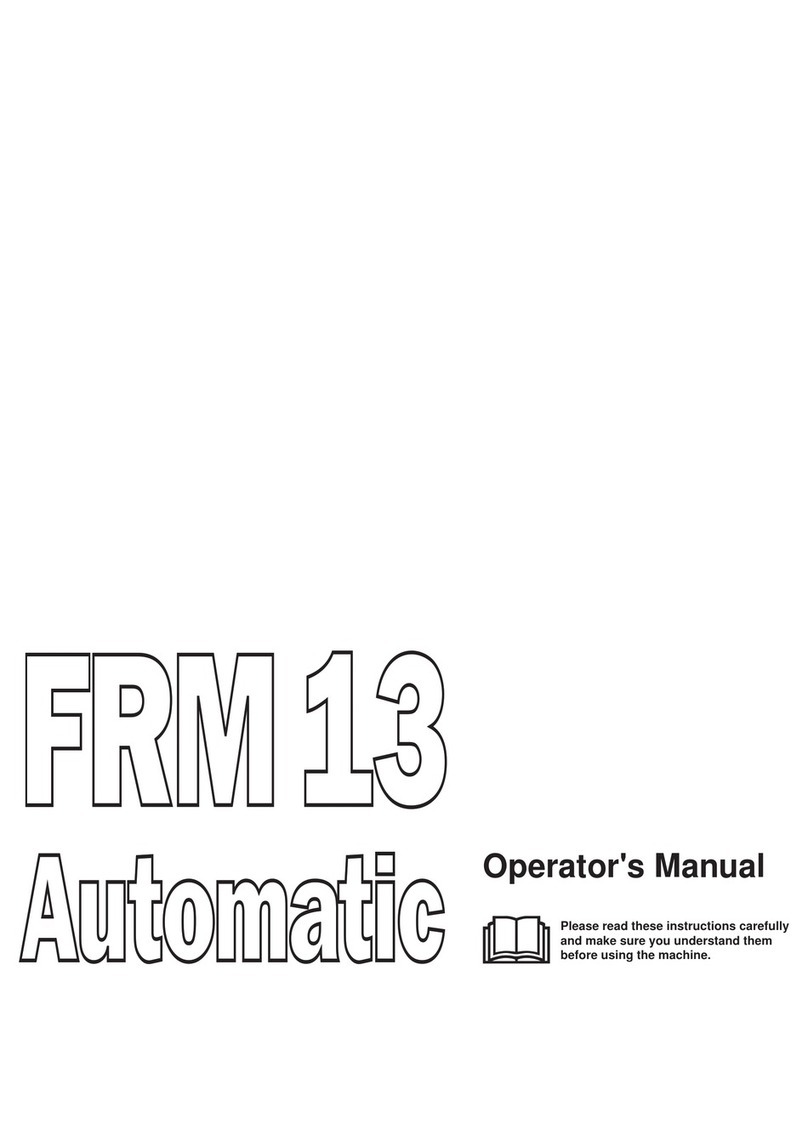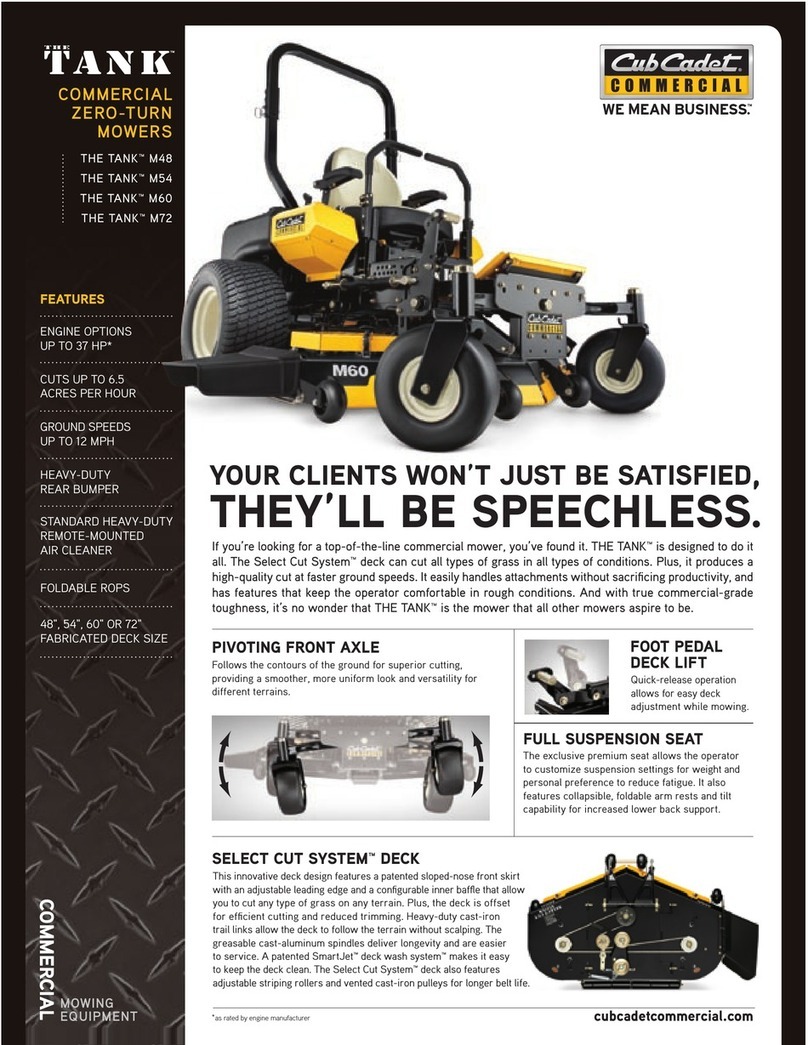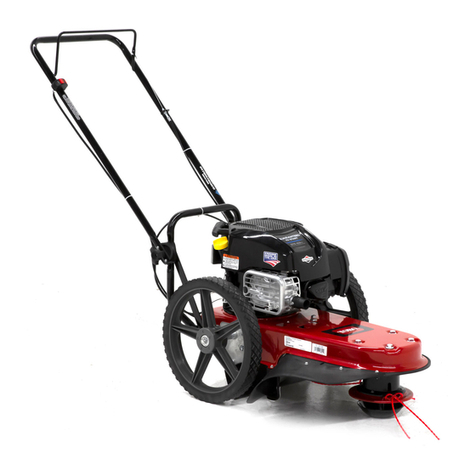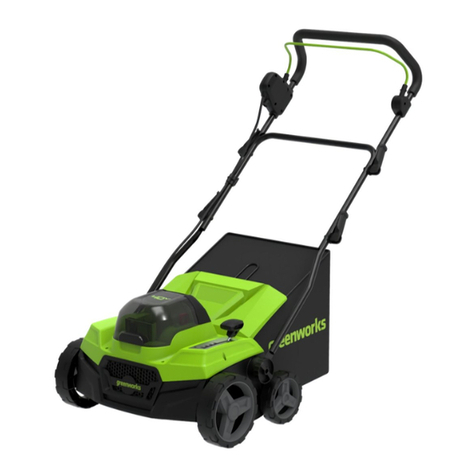Belrobotics Big mow BM 2050 User manual

Big mow BM 2050 User's Manual
Software version 4.5
Familiarity with the contents of this manual is required before operating the robot.
Belrobotics®, BM 1050® and BM 2050® are registered trademarks of Yamabiko Europe.
Avenue Lavoisier 35 • 1300 Wavre • Belgium
www.belrobotics.com

Copyright © Yamabiko Europe S.A./N.V.
All rights reserved.
This publication or parts thereof may not be reproduced in any form, by any method, for any purpose.
Disclaimer
Yamabiko Europe S.A./N.V. has taken reasonable care in compiling this document, however Yamabiko Europe S.A./N.V. accepts no
liability whatsoever for any error or omission in the information contained herein and gives no other warranty or undertaking as to its
accuracy.
Yamabiko Europe S.A./N.V. can accept no responsibility for damages, resulting from the operation of the equipment, its accessories
and peripherals, or any related software. Yamabiko Europe S.A./N.V. reserves the right to amend this document at any time without
prior notice.
Yamabiko Europe S.A./N.V. and its affiliates are not liable for damages and/or losses related to security breaches, any unauthorized
access, interference, intrusion, leakage and/or theft of data or information.

Contents
1 What's New...........................................................................................5
2 Introduction.......................................................................................... 8
3 Conventions used in the manual....................................................... 9
4 About RTK GPS................................................................................. 10
5 Big mow BM 2050 description..........................................................12
5.1 The robot.................................................................................................................13
5.1.1 Robot options............................................................................................. 17
5.2 The charging station............................................................................................... 19
6 Sensors............................................................................................... 21
7 How Big mow BM 2050 works..........................................................24
7.1 Operational state.....................................................................................................24
7.1.1 Work mode.................................................................................................25
7.1.2 Go to charging station mode......................................................................31
7.1.3 Charge mode..............................................................................................37
7.1.4 Border mode...............................................................................................38
7.1.5 Wait in charging station mode....................................................................39
7.1.6 Go zone mode............................................................................................39
7.2 Inactive state...........................................................................................................46
8 Using your robot................................................................................49
8.1 Safety measures..................................................................................................... 49
8.2 Safety notices..........................................................................................................50
9 The user interface..............................................................................52
9.1 User Interface Commands......................................................................................54
9.2 The Actions menu.............................................................................................55
9.3 The Settings menu ............................................................................................57
9.3.1 Schedule ..................................................................................................57
9.3.2 Cutting heads .......................................................................................... 60
9.3.3 Border ......................................................................................................61
9.3.4 Cutting height .......................................................................................... 61
9.3.5 System locking ........................................................................................ 64
9.3.6 LCD settings...............................................................................................64
9.4 The Service Settings menu ................................................................................65

9.4.1 Regional parameters..................................................................................65
9.4.2 Connections................................................................................................66
9.4.3 Operations.................................................................................................. 67
9.4.4 Device.........................................................................................................68
9.4.5 Security.......................................................................................................69
10 Service and Maintenance................................................................71
10.1 Maintenance..........................................................................................................71
10.1.1 Maintenance procedures..........................................................................72
10.1.2 Blade replacement....................................................................................77
11 Technical specifications Big mow BM 2050..................................78
12 Notices.............................................................................................. 80
13 Abbreviations....................................................................................81
14 Glossary............................................................................................82

Chapter 1 What's New
1 What's New
Software Version 4.5
• A GPS Navigation Zone (page 82) can be defined which encompasses an entire
working area. Multiple GPS zones can be defined within the navigation zone that do not
need to be connected to the loop or overlap with each other.
• GPS NoGo zones are always respected for both pattern and random working.
• Data corrections sent from the RTK base to the robots can be transmitted using 4G.
• The maximum slope allowed for pattern working is now 30%.
• Site requirements for pattern working have been improved in particular, navigation along
narrow passages.
• Pattern mowing in an RTK GPS zone can be switched on or off. This means that if there
are problems with the signal levels, or there are areas that are not suited to pattern
working, random working can be implemented.
• It is possible to specify the main orientation (heading) of the mowing pattern. This is
especially useful for sports pitches where it can be set to match exactly the lines defining
the pitch.
• Sonar problem detection and diagnostics have been improved.
• Border mode can now be executed by following the track wire or a set of GPS coordinates.
Software Version 4.4
• In pattern mowing, the overlap between lines has been reduced from 20cm to 10cm. This
increases the mowing efficiency by reducing the time to mow a particular area.
• Complex mowing areas are supported for pattern mowing.
• When mowing in pattern mode over multiple zones, the mowing in one zone will be
completed before mowing starts in another zone. See Choosing where to work (page
43).
• Improved GPS navigation.
This overcomes problems that could arise when the robot fails to calculate a GPS path to
the target point when it is close to the border of the field. This applies in particular to tight
corners with a small radius and when it is necessary to navigate through narrow passages.
• Track wire improvements.
This reduces the occurrence of alarms indicating "wire lost" during track wire movements
in corners.
• Track border improvements
This improves the navigation with a minimum track border distance (when the robot is
close to the wire) .
• Tilt alarm improvements
When using a high traction force to move the robot up a slope, the front is easily lifted,
triggering a tilt alarm causing the robot to stop.
Big mow BM 2050 User's Manual Version: Release 4.5.0 Last updated: 2022-08-20 5

Chapter 1 What's New
Figure 1: Tilt alarm triggered due to a slope
The robot now waits for a certain time to check whether the tilt situation has been
corrected. If it has, the robot will continue working.
• System level over-voltage, detection and protection of electronics.
The main bus voltage is now constantly monitored. If it reaches a critical level the
operation of the robot is shut down in a controlled manner to protect the electronics. If the
system voltage remains high when the robot tries to restart, an alarm is triggered.
• GPS defined NoGo zones can be implemented.
• Pattern mowing on slopes of up to 15% is possible.
Software Version 4.3
• Patterned mowing is possible for robots set up to use RTK GPS positioning system. See
About RTK GPS (page 10).
• Robots can now operate in border mode (page 38) for multi-field installations.
• It is possible to prevent mowing on a specified parcel by setting the cutting height of the
blades to "disabled" (page 61).
•Parcel choice is based on work history (page 43).
•A robot will not cross unavailable fields when starting a new mission (page 45).
• A Max short cycles allowed (page 68) parameter to limit the number of times the robot
will execute a very short working cycle can be set.
•Cutting heads disabled when returning to station (page 31).
•A robot will retry to dock after a failed connection (page 31).
Software Version 4.2
• Information about the portal is in a separate manual.
• Operation menu Brake on idle (page 67).
•Cutting heads (page 60). Cutting height can be set for a parcel.
• Return to station using GPS from multiple parcels. See Go to charging station mode (page
31).
• Exit from station using GPS. See Go zone mode (page 39).
• Options in a menu are presented graphically in a tree.
Release 4.1
• How to edit the robot's schedule using the web portal.
• The date format can be set using Service Settings > Regional parameters.
• The unit system used to display values can be set using Service Settings > Regional
parameters.
• The system of returning to the station using GPS.
• An overview of all the signal channels can be seen by pushing 8on the keyboard for 5
seconds.
6Big mow BM 2050 User's Manual Version: Release 4.5.0 Last updated: 2022-08-20

Chapter 1 What's New
• Additional information about the robot is available from Service Settings > Device.
• Additional icons have been added to the home screen on the user interface (page 52).
• The chapter on Troubleshooting has been temporarily removed and will be available
shortly.
Release 3.5.1
- Corrections in the text.
Release 3.5
- The release number of the manual has been adjusted to match the software version to
which it relates.
Note: This implies that there are no manuals with release numbers 3.2, 3.3 or 3.4
- Update to the troubleshooting section.
- Updates to the portal interface.
Release 3.1
- The contents of the How Big mow BM 2050 works (page 24) has been updated to
distinguish between installations that use a positioning beacon and those that use a "return
to station loop".
- In The Actions menu (page 55) there is a new option to start the robot working in a
specific parcel.
Release 3.0
LCD settings (page 64)
Big mow BM 2050 User's Manual Version: Release 4.5.0 Last updated: 2022-08-20 7

Chapter 2 Introduction
2 Introduction
This manual provides all the information required to use your Big mow BM 2050 battery
powered robotic lawnmower.
is the new version of the Bigmow robot. All the information in this manual refers to the
Bigmow robot using software version 4.5.
This manual contains the original instructions.
Your robot is installed by a Belrobotics authorized engineer. The configuration of your field is
analyzed to determine the most suitable robot. The peripheral wire is installed, and the robot
programmed according to the terrain and your requirements. Training is provided to enable
you to manage the robot autonomously.
Technical developments are taking place constantly, so the information contained in this
document is provided as an indication and is in no way contractual. It can be changed at any
moment by Belrobotics, without the need for prior announcement. Updated information can be
obtained from your dealer and the website https://myrobot.belrobotics.com/.
Big mow BM 2050 has been designed to high safety standards, but residual risks are always
possible and the recommended safety and protective measures must be followed.
Version
This manual refers to Software version 4.5
The current software version can be see by selecting -> Device from the interface screen
or by viewing information about the robot on the web portal.
Related documentation
For related documentation go to the Documentation section on the web portal https://
myrobot.belrobotics.com.
• MyRobot - User's Manual: for information about using the web portal.
• User manual (other languages).
• The required RTK Base manual.
Contact details
8Big mow BM 2050 User's Manual Version: Release 4.5.0 Last updated: 2022-08-20

Chapter 3 Conventions used in the manual
3 Conventions used in the manual
To charge the battery Indicates the start of a procedure to be
followed.
blue text (page 9) A link to another section of the manual.
green text (page 9) A link to a word in the glossary.
Use active periods Indicates an option to highlight in the user
interface.
this is less than 5m italic script for emphasis
1An entry in the user interface
Indicates a maintenance operation.
menu entry Sequence of menu selections in the
interface. Infrastructure > Peripheral
wires
PARCELS The name of a screen in the user interface.
{ } Indicates a variable parameter value.
Robot Wi-Fi Access User interface control on the smartphone
app
message Message displayed on the smartphone app
Big mow BM 2050 User's Manual Version: Release 4.5.0 Last updated: 2022-08-20 9

Chapter 4 About RTK GPS
4 About RTK GPS
Standard GPS positioning data retrieved from satellites using GNSS (Global Navigation
Satellite System) is accurate to between 5m and 10m. This is because the signal received
from a satellite is distorted due to atmospheric and environmental conditions. Higher precision
positioning can be achieved by using an RTK (Real-Time Kinematic) technique.
This technique involves the use of an RTK base placed in a fixed position, which receives
GNSS signals from satellites. Since the base is fixed, the data it receives relates to its precise
location.
The robots are fitted with antennas, which also receive GNSS signals from satellites to
determine their position. Both the RTK base and the robots receive the GNSS signals from
satellites in different constellations (GPS, GLONASS, Galileo, BeiDou). Since the robots are
moving however, the evaluation of their position is less precise.
The RTK base computes correctional data for each of the satellites and sends these to the
robot. The robot is then able to use these corrections to achieve a positional accuracy of
between 2cm and 3cm. With such accurate positioning, the robot is able to follow a defined
pattern and cover the field in a series of straight lines.
Communication between the robot and the RTK base using WiFi and can be made over a
distance of up to 200m if there are no obstacles in the way. If greater distances are required,
up to 2 WiFi repeaters can be used.
Figure 2: Transfer of corrections using WiFi
Corrections can also be made via the Belrobotics cloud using 4G. In this case, obstacles do
not impede the transfer of correctional data and the base can connect to an unlimited number
robots at distances of up to 15km.
10 Big mow BM 2050 User's Manual Version: Release 4.5.0 Last updated: 2022-08-20

Chapter 4 About RTK GPS
Figure 3: Transfer of corrections using 4G
One base station can feed corrections to multiple robots on the same site, but each robot
must receive corrections from only 1 base station to keep corrections consistent.
Subscriptions
The ability to use the RTK system to implement pattern working requires an annual
subscription. A free grace period of 2 months is provided after the initial installation of
the system. After this time, the payment of the annual subscription is required. Details on
subscriptions can be found in the MyRobots manual.
Advantages
Since the robot can mow in a well-defined pattern of straight lines, the time taken to mow an
area can be reduced relative to the time taken using a random trajectory. This means that:
• One robot can manage a larger area of grass.
• The time required to mow an area is reduced, so the selection of suitable work times is
much more flexible. Thus the robot can work when the field is not in use and does not
need to work at night, so reducing the danger to nocturnal animals.
• The grass is mown systematically. The direction of the mowing lines is changed with each
passage over the area to improve the quality of the mowing and avoid tracks.
Big mow BM 2050 User's Manual Version: Release 4.5.0 Last updated: 2022-08-20 11

Chapter 5 Big mow BM 2050 description
5 Big mow BM 2050 description
This topic describes all the mechanical characteristics of the robot and the charging station as
well as the specific hardware components required for using the RTK-GPS system.
Figure 4: Basic components of the RTK GPS mowing system
•The robots (page 13).
•The charging station (page 19)
• The RTK base and associated hardware. See About RTK GPS (page 10) for more details.
• Optional WiFi repeater. See About RTK GPS (page 10) for more details.
A user can exercise direct control over the robot using the User Interface. Once a robot is
registered on the portal running on a web-server:
- the robot can send information to this server which can be seen by the user
- the user can issue commands to the robot, assess its performance and adjust the
configuration.
Note however, that full control over the robot is only available with a subscription for that
robot.
Go to https://myrobot.belrobotics.com .
12 Big mow BM 2050 User's Manual Version: Release 4.5.0 Last updated: 2022-08-20

Chapter 5 Big mow BM 2050 description
5.1 The robot
Big mow BM 2050 components
Figure 5: Top view of robot components
(1) STOP button
Hitting this button will stop the robot at any point.
It is also a lid that provides access to the so-called smart box that contains the on board
computer that controls the operation of the robot. A user interface is provided with which
to set and modify the robot's operational parameters.
(2) Body
The body houses sensors and covers the mechanical components.
(3) Obstacle detection sonars
Sensors detect an object in the path of the robot. For more information see Sensors
(page 21).
(4) Front wheels
Front wheels.
(5) Bumper
The bumper (page 21) is a pressure sensor which will cause the robot to change
direction when it touches an obstacle.
(6) Rear wheels
The rear wheels are driven and are equipped with brakes to ensure safety on slopes or
when machine is stopped.
(7) Charge contacts
There are two pairs of charge contacts on either side of the robot. They connect with the
charging arms in the charging station.
Big mow BM 2050 User's Manual Version: Release 4.5.0 Last updated: 2022-08-20 13

Chapter 5 Big mow BM 2050 description
Figure 6: Bottom view of robot components
(8) Cutting heads
The robot is fitted with 5 rotating cutting heads. Each cutting head is equipped with three
cutting blades, which are rotated on the head and which cut the grass.
Figure 7: Detail of the cutting head
(A) Bracket
(B) Cable entry
(C) Motor housing
(D) Blade support disc
(E) Anti-friction disc
(F) Cutting blade
(G) Pantograph
Note: The blade support disc (D), the anti-friction disc (E) and the cutting blades
(F) are referred to collectively as the "cutting disc".
If a problem is detected it is possible to disable any number of cutting heads (page
60).
14 Big mow BM 2050 User's Manual Version: Release 4.5.0 Last updated: 2022-08-20

Chapter 5 Big mow BM 2050 description
Different types of cutting blades (page 18) are available depending on the mowing
conditions.
The cutting blades need to be replaced on a regular basis to ensure optimal mowing
performance. See changing the cutting blades (page 75).
The height of the cutting head determines the height of grass that is cut. This can be
adapted to match the required conditions. See setting the cutting height (page 61).
(9) Battery
An LFP battery powers Big mow BM 2050 whilst mowing. When the battery needs
charging the robot will return to the charging station.
(10) Sealed Electronic box (Smartbox)
This contains the electronics and the robot motor.
Note: This should only be opened or manipulated by an authorized technician.
(12) Coil
The robot is equipped with a coil that detects the magnetic field generated by the
peripheral wire. When the robot crosses the peripheral wire, it registers a change in
phase of the signal in the wire, which indicates it is leaving the field. As a consequence it
will change direction in order to return into the field.
(13) On/Off switch
Switches the robot on or off.
RTK GPS antenna
Figure 8: Location of the RTK GPS antenna
This is a specific GNSS antenna installed at center front of the shell. It is used to receive
data about the robot's global position from satellites.
Identification labels
The identification label can be found on the inside of the Stop button lid as shown below.
Figure 9: Identification label under the Stop lid.
Big mow BM 2050 User's Manual Version: Release 4.5.0 Last updated: 2022-08-20 15

Chapter 5 Big mow BM 2050 description
Dimensions
Figure 10: Rear view dimensions
Figure 11: Side view dimensions
16 Big mow BM 2050 User's Manual Version: Release 4.5.0 Last updated: 2022-08-20

Chapter 5 Big mow BM 2050 description
Figure 12: Bottom view dimensions
Technical details
For detailed technical specifications seeTechnical specifications Big mow BM 2050 (page
78) .
Sound level: The A-weighted emission sound pressure level is:
- >70dB dB at 1m distance
- 52 dB at 5m distance
Mass in kilograms: This can be seen on the identification label. See Figure 9: Identification
label under the Stop lid. (page 15).
5.1.1 Robot options
Wheel brushes
The wheel brushes are installed behind the rear wheels to clean them.
Groomer
A groomer is a device that can be fitted to the rear of the mower to improve the quality of the
grass.
Figure 13: Groomer
Big mow BM 2050 User's Manual Version: Release 4.5.0 Last updated: 2022-08-20 17

Chapter 5 Big mow BM 2050 description
The grooming device extends sprung tines vertically into the turf to remove thatch and
horizontal runners. The result is that the grass is stimulated into more active vertical growth
as well as improved aeration and water penetration. Their regular use throughout the growing
season leads to greatly improved turf on golf courses and playing fields.
Areas suitable for grooming Areas Unsuitable for grooming
Sports fields that are flat and kept free from
twigs, branches and dead leaves. Rough areas.
Areas with crossing paths.
Areas that are covered with leaves and
twigs during some parts of the year.
Blade types
Three types of cutting blades are available which vary in their hardness and durability.
Hard blades HRC 62
These blades can be identified by the engraving "0x".
These blades are durable and are not likely to break, but they have a tendency to wear
around the fixation hole.
Soft blade HRC 48
These blades can be identified by the engraving "01".
These blades are not likely to break, but they do deform and need to be changed every
week.
These blades are recommended for situations where the loss of a blade may cause
injury, as on a sports field for example.
Mid-hard blades HRC 58
These blades have no engraving on them.
They have an additional collar around the fixation hole which reduces the risk of
weakening in that area.
These blades are recommended for demanding applications.
Note: The longevity of a cutting blade can be extended by taking a number of
measures (page 77).
18 Big mow BM 2050 User's Manual Version: Release 4.5.0 Last updated: 2022-08-20

Chapter 5 Big mow BM 2050 description
5.2 The charging station
Figure 14: Components of the charging station
(1) Charge arms.
(2) Base.
(3) Occupation sensor. This is an optional feature indicating that the charging station is
occupied in charging a robot.
Figure 15: Rear view of the charging station
(4) LEDs which indicates the current state of the each wire:
•Green - blinking: wire is operating normally.
•Red - blinking: no peripheral wire can be detected.
This could be because the wire has been cut or that it is too long. Contact a technician.
•Red - steady: indicates a problem.
This could be due to the wire being too short, less than 200m, or there is a problem with
the electronics. Contact a technician.
(5) Identification label.
Big mow BM 2050 User's Manual Version: Release 4.5.0 Last updated: 2022-08-20 19

Chapter 5 Big mow BM 2050 description
(6) Input for power cable.
(7) Inputs for peripheral cables.
Technical details
Details of the charging station can be seen on the identification label.
Figure 16: Charging station identification label
20 Big mow BM 2050 User's Manual Version: Release 4.5.0 Last updated: 2022-08-20
Table of contents
Other Belrobotics Lawn Mower manuals
Popular Lawn Mower manuals by other brands
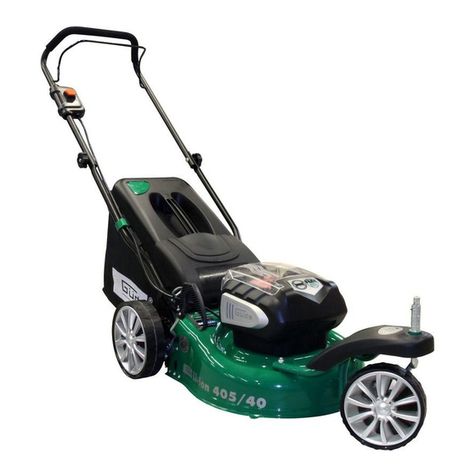
Gude
Gude TRIKE 405/40-2.6 S Translation of the original instructions
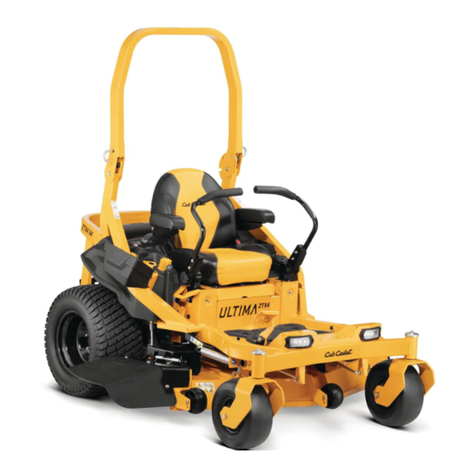
Cub Cadet
Cub Cadet 53AH8CTX750 Illustrated parts list
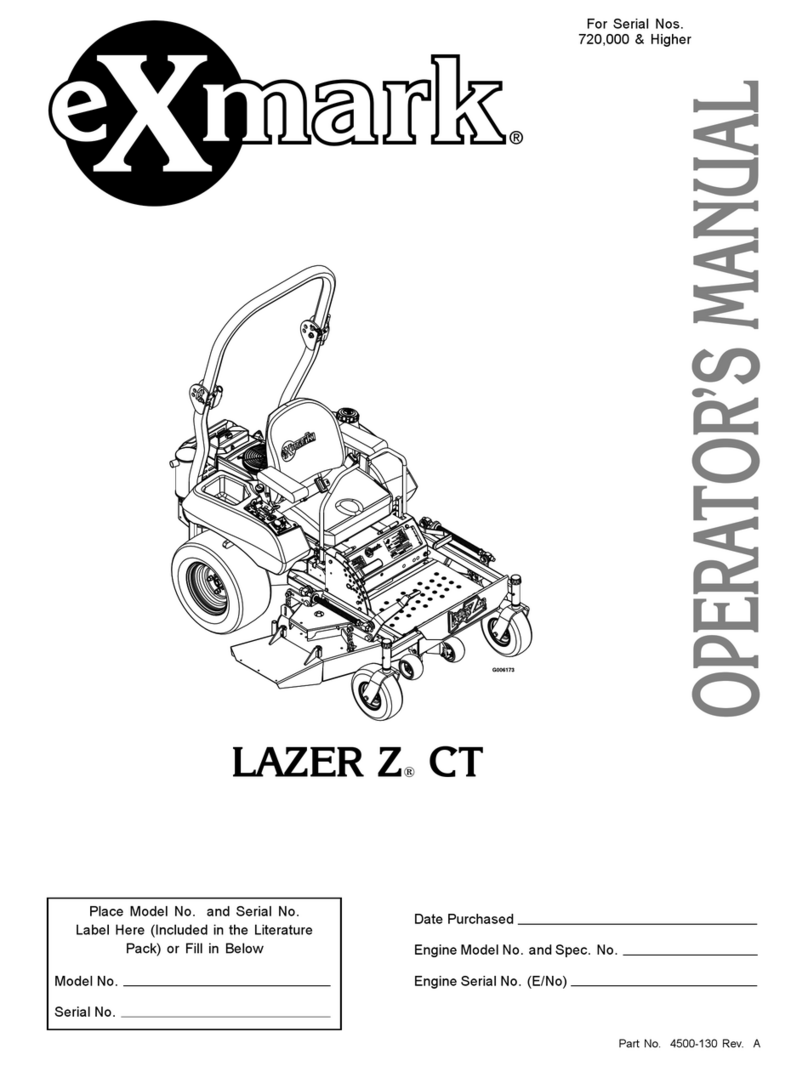
Exmark
Exmark Lazer Z CT Operator's manual
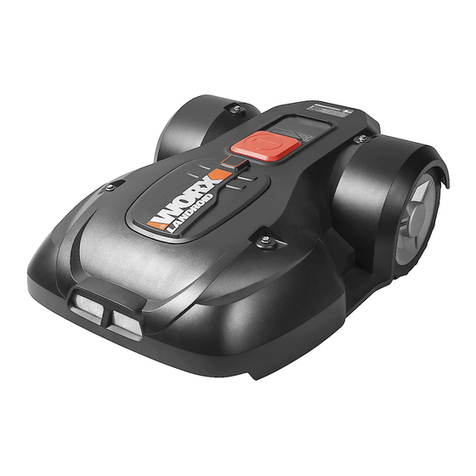
Worx
Worx LANDROID L WG792E Programming guide
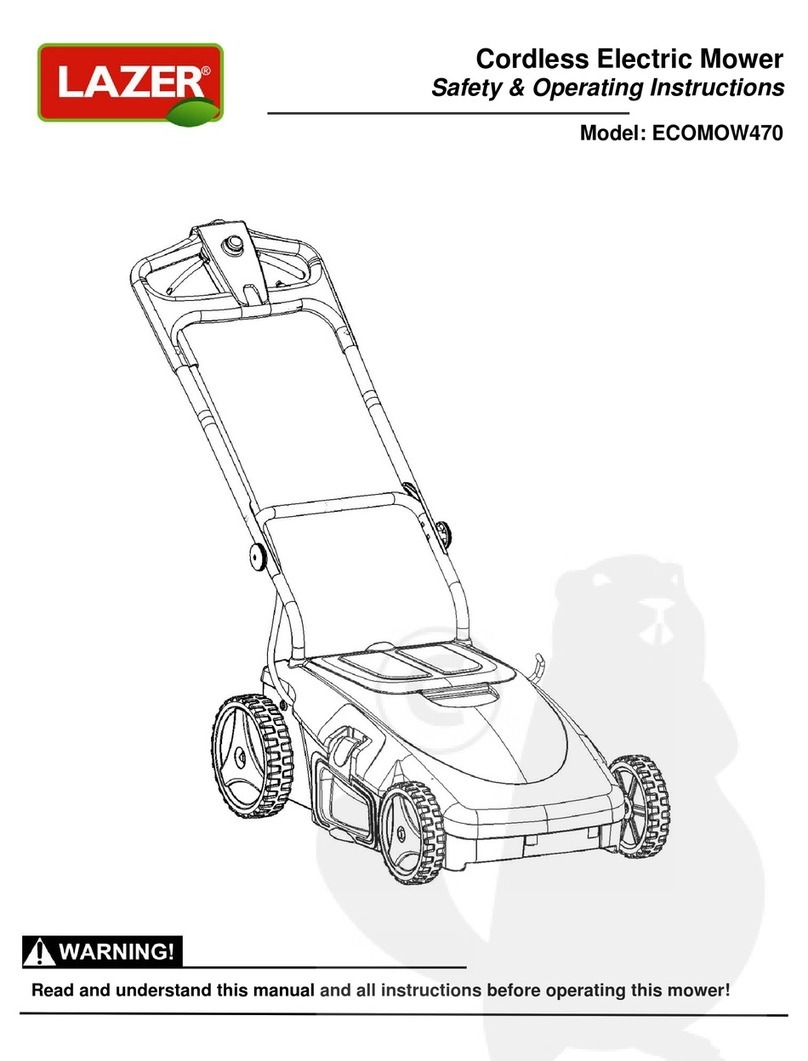
LAZER
LAZER ECOMOW470 Safety & Operating Instructions
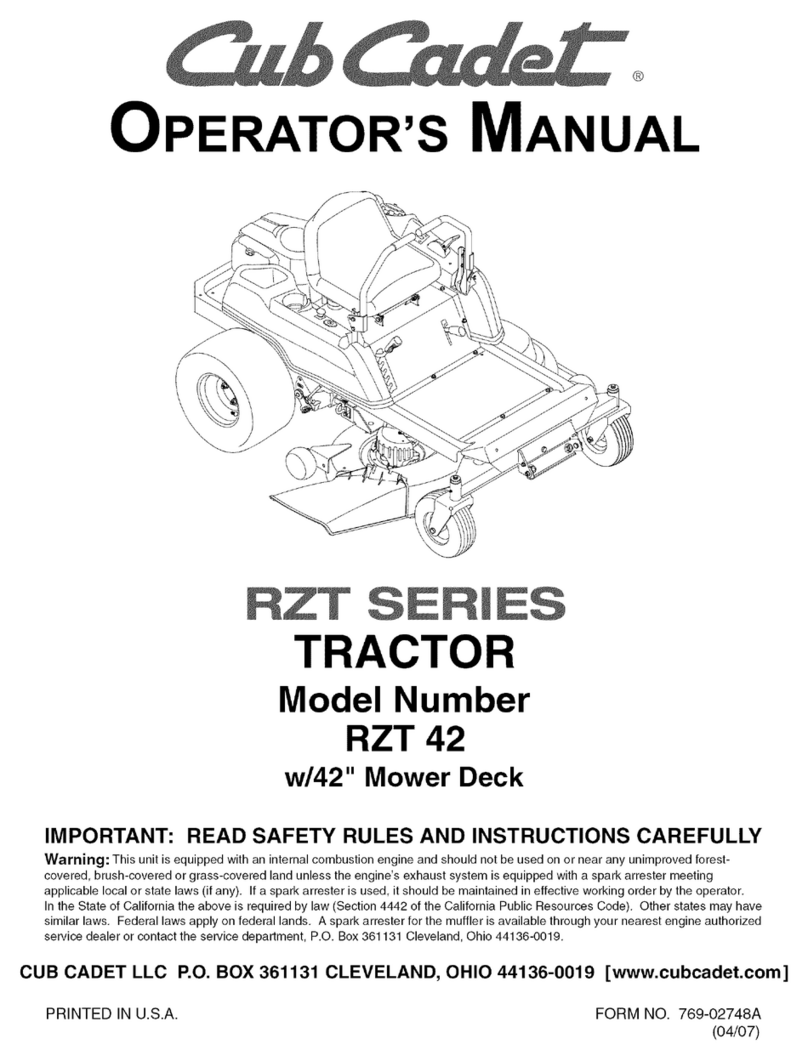
Cub Cadet
Cub Cadet RZT 42 w/42" Mower Deck Operator's manual
